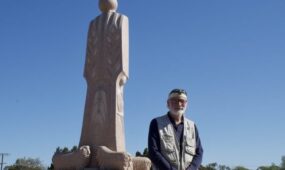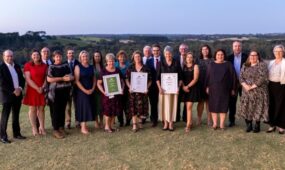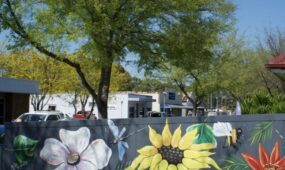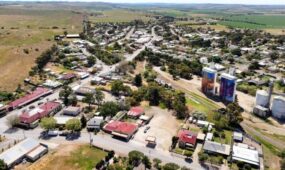Adnyamathanha language program takes huge strides
Regional
The Leigh Creek Area School and Leigh Creek Community Progress Association in South Australia are placing more bilingual signs along the Akurra Trail to the water’s edge of Arrunha Awl (Aroona Dam).

Sign up to receive notifications about new stories in this category.
Thank you for subscribing to story notifications.

The 10.5-kilometre trail with bilingual signposting was developed as part of the Leigh Creek School’s language learning program, which has been running since 2019 in partnership with the University of Adelaide’s Mobile Language Team (MLT).
For Clayton Cruse, a language teacher at the Leigh Creek School, the Akurra Trail – which opened to the public mid-last year – is significant in a town where there haven’t been public displays of Adnyamathanha culture or language.
“It was a really great opportunity for Adnyamathanha people to be involved in making Adnyamathanha culture and language visible,” Cruse said.
Recent funding has meant a Leigh Creek School student could help develop new signage for the trail as part of their SACE project, Adnyamathanha language coordinator Rosalie Richards said.
Working with Aboriginal community education officer Noel Wilton and Adnyamathanha elder Linda Coulthard, the student helped gather and write information for the signs, Richards said.
The trail was the Leigh Creek School’s response to a request from the parents and the Adnyamathanha Language and Culture Committee, which was “very active” in developing the language program, according to Richards.
“They said, ‘one of the main things we want to do is to make sure our children learn our Muda’,” she said.
“The Muda is the creation histories of the Country.”
The trail begins at the Leigh Creek township and leads to Arrunha Awi, or Aroona Dam – a significant site in one of the major Muda tracks across Adnyamathanha Country, Richards said.
Charted by students, staff and other community members, Cruse said the Akurra Trail provides a multifaceted learning experience.
“We know that Aboriginal students learn in a different way when they’re outside and that really extends to all students,” Cruse said. “Teaching Adnyamathanha language out on the land just makes sense.”
As part of their syllabus, students engage with the content of the signs – which includes information about flora, fauna and the seasons, as well as walking the trail for their physical education program, Richards said.

Clayton Cruse said the language learning program fosters a strong sense of identity. Photo: supplied.
Cruse said they are lucky to be able to simply drive down the road and show students the Muda sites they are learning about.
“Teaching them those histories through language makes the program extremely rich,” Cruse said.
Richards began developing the Akurra Trail after finding a brochure about the old trail in the local history collection.
“When I saw it, I thought this doesn’t even mention the Muda, it doesn’t mention that this is a really significant site. It doesn’t mention the Adnyamathanha people – it was just wrong,” she said.
“It’s just such a significant part of what the community wanted – to see the honouring of their Muda.”
Richards said Adnyamathanha elders are vital to the program, and not just because of the ongoing effects of historical, repressive language policies which mean they have the most language fluency.
“It makes it a much more authentic program for the students to be working with those elders,” she said.
“And they really enjoy the times that we’re able to take them out on Country – when they’re able to talk with the elders and learn directly from them.”

The Mobile Language Team helped produce a short film to highlight the significance of the Akurra Trail. Photo: supplied.
In 2021, the Mobile Language Team collaborated with filmmaker Max Mackinnon, to produce a short film on the Akurra Trail.
As part of the same program, Richards said, MLT worked with Adnyamathanha elders to translate another short film, Yurlu’s Coal, which shone light on a different Muda.
Cruse said the language program not only “fosters a great sense of pride in the elders” but also reinforces to the students that their culture and language are valuable and can be a “vehicle for learning”.
“Historically, there was this idea that you’d leave your culture and your language at the gate because you’re going in to learn in a Western system,” he said.
“What this [language learning] program really does is, it says to the Adnyamathanha community and to the wider community that it [Adnyamathanha culture] is something to be valued.”
The school is developing various other language-learning resources for the community, Richards said.
“We hope to be able to get some books published,” she said.
“We’ve got some beautifully illustrated books that students have made of some Muda stories. We’re just starting to get students involved in making language teaching films.
“One of our [students] has just completed a short film teaching verbs.”
Cruse, who is one of a handful of qualified Adnyamathanha language teachers, is set to leave the school to go back to living with his family.
What the bilingual program has implemented in the last three years – in the bigger scheme of language revitalisation – is “only a drop in the ocean”, he said.
There is a need for teachers equipped not only with language skills, Cruse said, but also a commitment to develop the program for generations.
“We’re really keen and eager for further support for Aboriginal language programs in schools to take place,” he said.
“What we know is that the majority of languages that are still spoken fluently are not spoken in the cities in Australia. They’re spoken in remote, rural locations.
“Getting people to go through university and then relocate back to their communities to be involved in this kind of work is a massive undertaking and something that really needs to be taken seriously and further developed.”
Richards said they hope to see a lot more support coming in given the International Decade of Indigenous Languages began this year.
“Ideally, we would have a linguist here able to work on the resources,” she said.
“Because we’re teachers at the school, we don’t have the time that we would like to record the language.”
Cruse also said that while the school has been “really lucky”, federal funding for Aboriginal languages more broadly is inadequate.
“The reality is there are hundreds of other languages out there in Australia that are in severe danger of being lost completely,” Cruse said.
“We need to see a more adequate funding model to support all language groups who want to be involved in this kind of work because what we’re seeing is Aboriginal people losing our linguistic heritage, and that needs to be reversed.”
More information on the Akurra Trail and the PDF map can be found on the Mobile Language Team website.
Jump to next article




